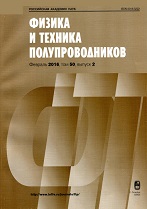|
This article is cited in 4 scientific papers (total in 4 papers)
Semiconductor physics
Influence of double- and triple-layer antireflection coatings on the formation of photocurrents in multijunction III–V solar cells
S. B. Musalinova, A. P. Anzulevicha, I. V. Bychkova, A. S. Gudovskikhb, M. Z. Shvartsc
a Chelyabinsk State University
b Federal State Budgetary Institution of Higher Education and Science Saint Petersburg National Research Academic University of the Russian Academy of Sciences, St. Petersburg
c Ioffe Institute, St. Petersburg
Abstract:
The results of simulation by the transfer-matrix method of TiO$_{2}$/SiO$_{2}$ double-layer and TiO$_{2}$/Si$_{3}$N$_{4}$/SiO$_{2}$ triple-layer antireflection coatings for multijunction InGaP/GaAs/Ge heterostructure solar cells are presented. The TiO$_{2}$/SiO$_{2}$ double-layer antireflection coating is experimentally developed and optimized. The experimental spectral dependences of the external quantum yield of the InGaP/GaAs/Ge heterostructure solar cell and optical characteristics of antireflection coatings, obtained in the simulation, are used to determine the photogenerated current densities of each subcell in the InGaP/GaAs/Ge solar cell under AM1.5D irradiation conditions (1000 W/m$^2$) and for the case of zero reflection loss. It is shown in the simulation that the optimized TiO$_{2}$/Si$_{3}$N$_{4}$/SiO$_{2}$ triple-layer antireflection coating provides a 2.3 mA/cm$^2$ gain in the photocurrent density for the Ge subcell under AM1.5D conditions in comparison with the TiO$_{2}$/SiO$_{2}$ double-layer antireflection coating under consideration. This thereby provides an increase in the fill factor of the current–voltage curve and in the output electric power of the multijunction solar cell.
Received: 20.06.2016
Accepted: 29.06.2016
Citation:
S. B. Musalinov, A. P. Anzulevich, I. V. Bychkov, A. S. Gudovskikh, M. Z. Shvarts, “Influence of double- and triple-layer antireflection coatings on the formation of photocurrents in multijunction III–V solar cells”, Fizika i Tekhnika Poluprovodnikov, 51:1 (2017), 89–93; Semiconductors, 51:1 (2017), 88–92
Linking options:
https://www.mathnet.ru/eng/phts6263 https://www.mathnet.ru/eng/phts/v51/i1/p89
|


| Statistics & downloads: |
| Abstract page: | 28 | | Full-text PDF : | 6 |
|





 Contact us:
Contact us: Terms of Use
Terms of Use
 Registration to the website
Registration to the website Logotypes
Logotypes








 Citation in format
Citation in format 
